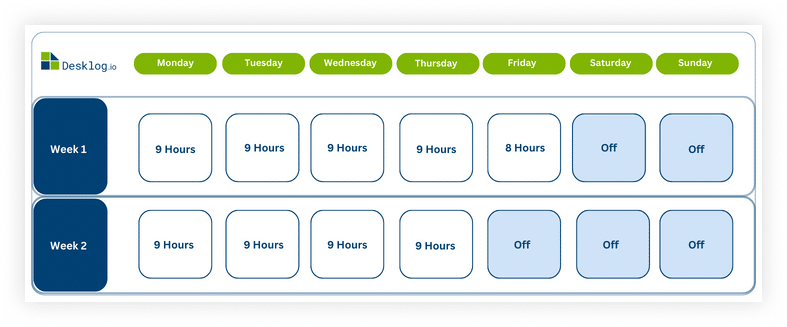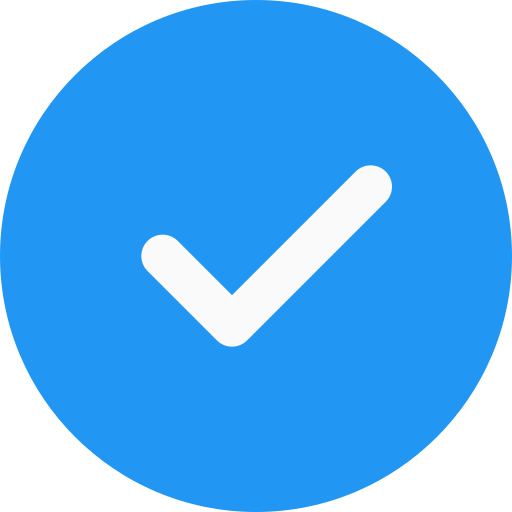A wide variety of schedules juggling in the landscape, choosing the one that suits your business needs is a bit confusing. Well, if you are in the tech, finance, or a marketing sector, then I have a suggestion that will resonate with you: ‘The 9/80 work schedule’.
But what exactly does it entail, and why is it gaining such prominence? In this blog, we delve deeper into the working of the 9/80 work schedule, exploring its significance in today’s dynamic work landscape.
Let’s dive in!
What is the 9/80 Work Schedule?
A 9/80 work schedule consists of eight nine-hour days, one eight-hour day, and one day off over the course of two work weeks. More specifically, instead of working 10 days (assuming a five-day workweek), employees on a 9/80 work schedule work 80 hours over nine days (thus the name: 9 days/80 hours).
It represents a flexible alternative to the traditional Monday-to-Friday, nine-to-five grind. The specifics may vary depending on company policies and agreements, but a common implementation involves working nine-hour shifts Monday through Thursday, with every other Friday off.

To illustrate, let’s break down a typical two week period under the 9/80 schedule:

Week 1:
Monday to Thursday: 9 hours per day (totaling 36 hours)
Friday: 8 hours (totaling 8 hours)

Week 2:
Monday to Thursday: 9 hours per day (totaling 36 hours)
Friday: Off
This arrangement allows employees to fulfill their 80-hour work requirement while enjoying the benefit of a three-day weekend every other week.

Did you know?
Andy Lynch, CEO of North Star Marketing, who promoted 9/80 schedule said, “The 9/80 schedule gives our team time to recharge at regular intervals. It’s good for them, their families and our clients.”
Benefits of the 9/80 Work Schedule
Embracing a 9/80 work schedule is about fundamentally reshaping the way we approach work and life. Here, we explore the myriad benefits that this innovative schedule brings to both employees and employers alike.

Work-life Balance
The 9/80 schedule creates a healthier equilibrium between professional responsibilities and personal pursuits. With longer weekends every other week, employees have ample time to recharge, pursue hobbies, and nurture relationships, leading to greater overall well-being.

Increased Productivity
The extra day off is often viewed by employees as a deserved bonus. This can motivate them to be more diligent and committed during the workweek. The longer weekend could boost morale, fostering a more optimistic attitude towards their responsibilities.

Less Commuting
The 9/80 schedule offers a reduction in commuting time and associated stress. This not only contributes to environmental sustainability but also allows employees to reclaim valuable hours otherwise spent on the road.

Improved Task Completion
The work hours on the 9/80 schedule provide more time for employees to tackle complex projects and tasks without feeling rushed. With fewer time constraints, work can be approached methodically, leading to more thorough and polished outcomes.

Better Rest
With a full day off every other week, employees have the opportunity to rest, reducing the risk of burnout & improving overall health and well-being. This dedicated time ensures that employees return to work feeling refreshed and ready to tackle new challenges.

More Flexibility
The 9/80 schedule provides employees with greater autonomy over their time, allowing them to schedule appointments, and manage personal commitments more effectively. This flexibility fosters a sense of empowerment and ownership over one’s schedule.
Related: Want to know more about 2-2-3 work schedule ? Read our blog.
Navigating the Challenges of the 9/80 Work Schedule
While the 9/80 schedule offers numerous advantages, it’s not without its hurdles. In this section, we explore the challenges that organizations may encounter when implementing this innovative work schedule.

Longer Workdays
One of the primary challenges of the 9/80 schedule is the longer workdays. For some employees, maintaining focus and productivity during extended hours leads to fatigue and decreased efficiency towards the end of the day.

Problems with Focus
Extended workdays might result in difficulties maintaining focus and concentration throughout the day. Without adequate breaks and rest periods, employees may experience lesser productivity and engagement, particularly towards the end of the workday.

Staffing Gaps
Staffing gaps may arise while operating a 9/80 work schedule, especially if employees’ days off are not aligned, leading to operational inefficiencies and increased workload for remaining team members.

Inactive Customer and Business
Misalignment of schedules between businesses and clients can result in periods of inactivity or reduced accessibility. This can hinder communication and collaboration, impacting customer satisfaction and business operations.

Sick Leave
Managing sick leave within the framework of a 9/80 schedule requires careful planning and communication. Employees may face challenges coordinating sick days with their designated workdays, potentially leading to disruptions in workflow and productivity.

Issue with Overtime
Balancing overtime hours within the constraints of a 9/80 schedule requires vigilant oversight. Without proper tracking and management, employees may exceed their allotted hours, leading to potential burnout and legal compliance issues.
Implementing the 9/80 Work Schedule: A Step-by-Step Guide
Transitioning to a 9/80 work schedule requires careful planning and consideration to ensure a smooth and successful implementation. Follow these steps to effectively introduce the 9/80 schedule in your organization:
Step 1: Assess Feasibility and Readiness
Before implementing the 9/80 schedule, assess the feasibility and readiness of your organization. Consider factors such as operational requirements, employee preferences, and potential impact on productivity.
Step 2: Communicate with Stakeholders
Engage with key stakeholders, including employees, managers, and HR representatives, to communicate the motive behind adopting the 9/80 schedule. Address any concerns or questions and ensure that everyone understands the benefits.
Step 3: Establish Clear Policies and Guidelines
Develop comprehensive policies and guidelines outlining the specifics of the 9/80 schedule, including working hours, days off, overtime procedures, and attendance expectations. Ensure that all employees have access to this information.
Step 4: Gather Employee Feedback
Seek input from employees regarding their preferences and concerns regarding the 9/80 schedule. Consider conducting surveys or focus groups to gather feedback and address any potential challenges or issues proactively.
Step 5: Train Managers and Supervisors
Provide training and support for managers and supervisors to effectively manage teams under the 9/80 schedule. Equip them with the necessary tools and resources like a time tracking software to track productivity, and support employee well-being.
Step 6: Implement and Monitor
Once you’re ready to roll out the 9/80 schedule, implement it gradually across the organization. Analyze the transition process closely, gathering feedback from employees and managers to identify and address any issues that arise.
Step 7: Evaluate and Adjust
Continuously evaluate the effectiveness of the 9/80 schedule based on key metrics such as productivity, employee satisfaction, and business outcomes. Be prepared to make adjustments and refinements as needed to optimize the schedule and ensure its success in the long term.
By following these steps and taking a proactive approach to implementation, businesses can successfully introduce the 9/80 work schedule and reap the benefits of improved work-life balance, increased productivity, and enhanced employee satisfaction.

Did you know?
2 2 3 shift is another work schedule method used by organizations to schedule their shifts.
Manage your Schedule with A Software Tool
After this detailed discussion, you might have understood that managing this schedule is a highly daunting task. Here’s where employee scheduling software steps in, becoming your companion for a smooth-running 9/80 work schedule.

Effortless Scheduling
Manually crafting a 9/80 schedule that considers employee preferences, leave requests, and business needs is a nightmare. Scheduling software automates this, ensuring fair rotation and leave management coverage across the cycle.

Payroll Errors
With a 9/80, payroll becomes difficult. The software tracks work hours accurately for the cycles, accounting for the shorter second week and any overtime. No more struggling at the end of the month!

Transparency for All
Communication is key in a 9/80 schedule. Employee scheduling software allows for easy access to schedules, time-off requests, and shift swaps, keeping everyone informed and on the same page.

Data-Driven Decisions
Scheduling software offers analytics that can identify staffing gaps or overworked employees on long workdays. This allows you to fine-tune the schedule for optimal efficiency and employee well-being.
Closing Remarks
In essence, the 9/80 work schedule offers a promising alternative for achieving work-life balance and increasing productivity. However, implementing and managing a 9/80 work schedule effectively requires careful planning and coordination.
Incorporating a scheduling software solution into your organization can empower both managers and employees to make the most of the 9/80 work schedule, optimizing productivity and fostering a healthier work environment.
So why wait? Take the first step towards efficient schedule management today and reap the benefits.
FAQ
1What is a 9-80 schedule template?
The 9/80 schedule is a two-week work arrangement where the standard 80 work hours are condensed into nine days instead of the usual ten. This schedule grants employees an additional day off every two weeks.
2What is the 8 80 schedule?
The “8 and 80” schedule allows employers to compensate employees at one and a half times their regular rate for hours worked beyond 8 in a workday or 80 hours over a two-week period.
3What is the 9 hour shift model?
The 9-hour workday with rotating off days is awork schedule where employees work nine hours daily with a rotating schedule for days off. This arrangement leverages longer workdays to grant additional days off, promoting a balanced work-life harmony.
4What is a rolling 8 schedule?
This is a rotating shift with four teams and three 8-hour shifts to ensure 24/7 coverage. Each team follows a rotating sequence over a 28-day cycle: 7 day shifts followed by 2 days off, then 7 swing shifts followed by 2 days off, and finally 7 night shifts followed by 3 days off.
5What is a 9-to-5 shift?
A 9-to-5 workday is the typical work schedule each employee is required to work. Here, employees have to log a standard 40-hour workweek. Their working day starts from 9 in the morning and ends at 5 in the evening.

